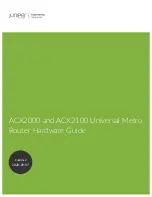
8
Introduction to LonWorks Routers
Router Types
A L
ON
W
ORKS
router can use one of four routing algorithms: configured router,
learning router, bridge, and repeater. This selection allows you to trade system
performance for ease of installation. The configured router and learning router
algorithms create intelligent routers that selectively forward messages based on
network topology. Both sides of a router must use the same routing algorithm.
The following general rules apply to all four routing algorithms:
•
For a message to be forwarded, it must fit into the router’s input and
output message buffers. A free input message buffer must be available.
•
For a message to be forwarded, it must have a valid cyclic redundancy
check (CRC) code.
•
Priority messages are forwarded as priority messages, but with the
priority level of the transmitting side rather than the priority level of the
originator of the message. If the transmitting side has not been installed
with a priority value, then priority messages are not forwarded in a
priority slot. The priority message is still flagged as a priority message,
so that if it passes through a second router that is installed with a
priority level, the second router transmits the message in a priority slot.
Repeater
A
Repeater
is a router that forwards all messages in both directions, regardless of
the message’s destination or domain. That is, a repeater forwards all valid
messages (that is, messages with a valid CRC code) to the other channel.
A
Permanent Repeater
behaves similarly, but its type cannot be changed after
creation.
Bridge
A
Bridge
is a router that forwards all messages received on either of the router’s
domains, regardless of the message’s destination. That is, a bridge forwards
packets received on one channel to the other channel, if the packet is sent on a
domain to which the bridge belongs. Use a bridge to span domains. In a single
domain network, a bridge functions essentially the same as a repeater.
A
Permanent Bridge
behaves similarly, but its type cannot be changed after
creation.
Configured Router
A
Configured Router
determines which packets to forward based on internal
routing tables. A configured router forwards only those messages which are
received on either of the router’s domains and which meet the forwarding rules
shown in
Figure 4
on page 10 and
Figure 5
on page 11. Configured routers
maintain their routing tables in non-volatile memory, and thus retain them after
a reset. These tables control forwarding of subnet and group-addressed
messages, and are managed by a network management tool.
Содержание 14315R
Страница 1: ...LONWORKS Router User s Guide 078 0018 01E...
Страница 6: ......
Страница 9: ...Appendix A Communications Parameters for LonWorks Routers 81 Communications Parameters 82...
Страница 10: ......
Страница 48: ......
Страница 53: ...LonWorks Router User s Guide 43 Figure 22 Router 5000 Mechanical Specifications...
Страница 54: ......
Страница 57: ...LonWorks Router User s Guide 47 Figure 23 RTR 10 Motherboard Example Schematic...
Страница 61: ...LonWorks Router User s Guide 51 Figure 26 Router 5000 Motherboard Example Schematic Core...
Страница 62: ...52 Developing a LonWorks Router Figure 27 Router 5000 Motherboard Example Schematic Network...
Страница 68: ......
Страница 80: ......
Страница 99: ...www echelon com...















































